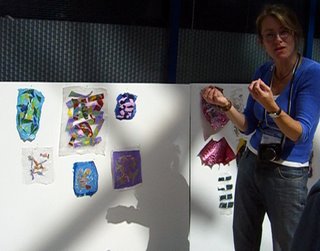I've been hoarding some geographical, historical - even cosmic - UK stamps. Too good to use!

 That gridded quilt thing, cumulation, happens in sheets of stamps -- more is so much more.
That gridded quilt thing, cumulation, happens in sheets of stamps -- more is so much more.

 That gridded quilt thing, cumulation, happens in sheets of stamps -- more is so much more.
That gridded quilt thing, cumulation, happens in sheets of stamps -- more is so much more.
 Left to right, in order of going into the dyebath, are: cotton, laid flat; cotton, twisted and knotted, wet; cotton, twisted and knotted, dry; calico, folded but not clamped; linen; silk organdie, folded and sewn shibori; silk organdie, scrunched. Such a variation! The only piece with actual black on it is the scrunched silk organdie.
Left to right, in order of going into the dyebath, are: cotton, laid flat; cotton, twisted and knotted, wet; cotton, twisted and knotted, dry; calico, folded but not clamped; linen; silk organdie, folded and sewn shibori; silk organdie, scrunched. Such a variation! The only piece with actual black on it is the scrunched silk organdie. The rain on the train is quickly gone again --
The rain on the train is quickly gone again -- When I got home I laid out my purchases - Tanne threads and shibori made by a Japanese master craftsman.
When I got home I laid out my purchases - Tanne threads and shibori made by a Japanese master craftsman.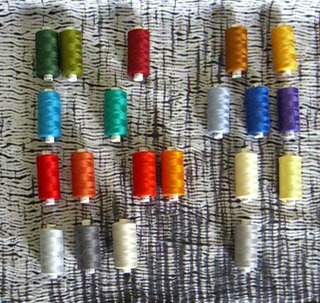 Here, at last, endeth the posts about the Festival of Quilts 2006. Back to "real life".
Here, at last, endeth the posts about the Festival of Quilts 2006. Back to "real life".
 "Homage to Gee's Bend" by Janet Bolton --
"Homage to Gee's Bend" by Janet Bolton -- Clyde Oliver's stitched slate --
Clyde Oliver's stitched slate --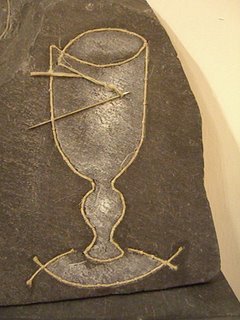 Detail of work by Diana Harrison --
Detail of work by Diana Harrison --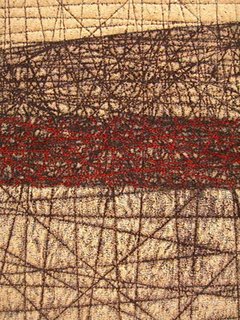 Two pieces from Judith James's exhibition --
Two pieces from Judith James's exhibition --
 Lovely rhythms of colours, by Christine Restall --
Lovely rhythms of colours, by Christine Restall -- Margaret Anderson's quilt incorporates various non-fabric materials --
Margaret Anderson's quilt incorporates various non-fabric materials --




 In the "quilts from Turkey" exhibit --
In the "quilts from Turkey" exhibit --
 Bailey spotted the tripod, and the woman with the camera is Bonnie Lyn McCaffrey, over from the States and recording the show (she's the pioneer of quilting video podcasts). Bailey's latest book is "Inspiration Plus" - just out, it's not on Bailey's website yet.
Bailey spotted the tripod, and the woman with the camera is Bonnie Lyn McCaffrey, over from the States and recording the show (she's the pioneer of quilting video podcasts). Bailey's latest book is "Inspiration Plus" - just out, it's not on Bailey's website yet. Susan has been monoprinting over tiles, a technique from Sue Dove's workshop at the Contemporary Quilt summer school.
Susan has been monoprinting over tiles, a technique from Sue Dove's workshop at the Contemporary Quilt summer school. Sandy finished her C&G in fashion, and then won the student category. Her other work in the show included the Tudor gown she made during the course.
Sandy finished her C&G in fashion, and then won the student category. Her other work in the show included the Tudor gown she made during the course.
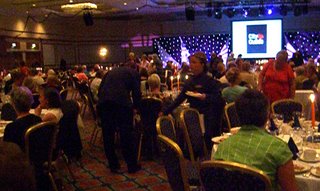 But the after-dinner speaker was Michael James, and he said four things:
But the after-dinner speaker was Michael James, and he said four things: Her show within the show had pieces of various sizes, in her characteristic muted colours.
Her show within the show had pieces of various sizes, in her characteristic muted colours.
 And she passed samples around; the next day they were heaped up in her booth.
And she passed samples around; the next day they were heaped up in her booth.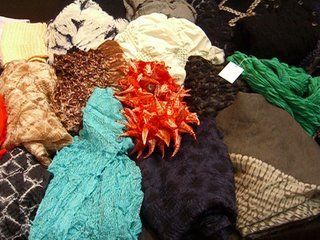
 And here we are in our windowless room, ready to go with lovely new Berninas, irons, and baking parchment.
And here we are in our windowless room, ready to go with lovely new Berninas, irons, and baking parchment. Our materials -- plastic bags!
Our materials -- plastic bags! One of the big lessons of this workshop, for me, is the importance of light. At the end of the first morning, we had a look at what everyone had done -- out in the concourse, where natural light streamed in and the sunshine lit up the work -- what a difference!
One of the big lessons of this workshop, for me, is the importance of light. At the end of the first morning, we had a look at what everyone had done -- out in the concourse, where natural light streamed in and the sunshine lit up the work -- what a difference!
